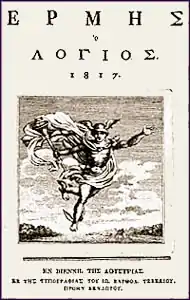Rise of nationalism in the Ottoman Empire
The rise of the Western notion of nationalism under the Ottoman Empire eventually caused the breakdown of the Ottoman millet concept. An understanding of the concept of the nationhood prevalent in the Ottoman Empire, which was different from the current one as it was centered on religion, was a key factor in the decline of the Ottoman Empire.
| History of the Ottoman Empire |
| Social structure |
|---|
| Court and aristocracy |
| Millets |
| Rise of nationalism |
Background
In the Ottoman Empire, the Islamic faith was the official religion, with members holding all rights, as opposed to non-Muslims, who were restricted.[1] Non-Muslim (dhimmi) ethno-religious[2] legal groups were identified as different millets, meaning "nations".[1]
Ideas of nationalism emerged in Europe in the 19th century at a time when most of the Balkans were still under Ottoman rule. The Christian peoples of the Ottoman Empire, starting with Serbs and Greeks, but later spreading to Montenegrins and Bulgarians, began to demand autonomy in a series of armed revolts beginning with the Serbian Revolution (1804–17) and the Greek War of Independence (1821–29), which established the Principality of Serbia and Hellenic Republic.[3] The first revolt in the Ottoman Empire fought under a nationalist ideology was the Serbian Revolution.[4] Later the Principality of Montenegro was established through the Montenegrin secularization and the Battle of Grahovac. The Principality of Bulgaria was established through the process of the Bulgarian National Revival, and the subsequent National awakening of Bulgaria, establishment of the Bulgarian Exarchate, April Uprising of 1876 and the Russo-Turkish War (1877–1878).
The radical elements of the Young Turk movement in the early 20th century had grown disillusioned with what they perceived to be the failures of 19th-century Ottoman reformers, who had not managed to stop the advance of European imperialism or the spread of nationalist movements in the Balkans. These sentiments were shared by the Kemalists. These groups decided to abandon the idea of Ittihad-i anasır - "Unity of the Ethnic Elements" - that had been a fundamental principle of the reform generation, and take up instead the mantle of Turkish nationalism.[5]
Michael Hechter argues that the rise of nationalism in the Ottoman Empire was the result of a backlash against Ottoman attempts to institute more direct and central forms of rule over populations which had previously had greater autonomy.[6]
Albanians
The 1877–78 Russo-Turkish War dealt a decisive blow to Ottoman power in the Balkan Peninsula, leaving the empire with only a precarious hold on Macedonia and the Albanian-populated lands. The Albanians' fear that the lands they inhabited would be partitioned among Montenegro, Serbia, Bulgaria, and Greece fueled the rise of Albanian nationalism. The first postwar treaty, the abortive Treaty of San Stefano signed on March 3, 1878, assigned Albanian-populated lands to Serbia, Montenegro, and Bulgaria. Austria-Hungary and the United Kingdom blocked the arrangement because it awarded Russia a predominant position in the Balkans and thereby upset the European balance of power. A peace conference to settle the dispute was held later in the year in Berlin.
Arabs
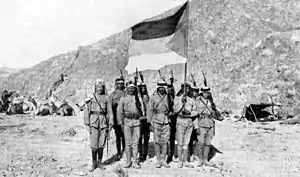
Arab nationalism is a nationalist ideology that arose in the 20th century[7] mainly as a reaction to Turkish nationalism. It is based on the premise that nations from Morocco to the Arabian peninsula are united by their common linguistic, cultural and historical heritage.[7] Pan-Arabism is a related concept, which calls for the creation of a single Arab state, but not all Arab nationalists are also Pan-Arabists. In the 19th century in response to Western influences, a radical change took shape. Conflict erupted between Muslims and Christians in different parts of the empire in a challenge to that hierarchy. This marked the beginning of the tensions which have to a large extent inspired the nationalist and religious rhetoric in the empire's successor states throughout the 20th century.[8][9]
A sentiment of Arab tribal solidarity (asabiyya), underlined by claims of Arab tribal descent and the continuance of classical Arabic exemplified in the Qur'an, preserved, from the rise of Islam, a vague sense of Arab identity among Arabs. However, this phenomenon had no political manifestations (the 18th-century Wahhabi movement in Arabia was a religious-tribal movement, and the term "Arab" was used mainly to describe the inhabitants of Arabia and nomads) until the late 19th century, when the revival of Arabic literature was followed in the Syrian provinces of the Ottoman Empire by a discussion of Arab cultural identity and demands for greater autonomy for Syria. This movement, however, was confined almost exclusively to certain Christian Arabs, and had little support. After the Young Turk Revolution of 1908 in Turkey, these demands were taken up by some Syrian Muslim Arabs and various public or secret societies (the Beirut Reform Society led by Salim Ali Salam, 1912; the Ottoman Administrative Decentralization Party, 1912; al-Qahtaniyya, 1909; al-Fatat, 1911; and al-Ahd, 1912) were formed to advance demands ranging from autonomy to independence for the Ottoman Arab provinces. Members of some of these groups came together at the request of al-Fatat to form the Arab Congress of 1913 in Paris, where desired reforms were discussed.
Armenians
Until the Tanzimat reforms were established, the Armenian millet was under the supervision of an Ethnarch ('national' leader), the Armenian Apostolic Church. The Armenian millet had a great deal of power - they set their own laws and collected and distributed their own taxes. During the Tanzimat period, a series of constitutional reforms provided a limited modernization of the Ottoman Empire also to the Armenians. In 1856, the "Reform Edict" promised equality for all Ottoman citizens irrespective of their ethnicity and confession, widening the scope of the 1839 Edict of Gülhane.
To deal with the Armenian national awakening, the Ottomans gradually gave more rights to its Armenian and other Christian citizens. In 1863 the Armenian National Constitution was the Ottoman-approved form of the "Code of Regulations" composed of 150 articles drafted by the "Armenian intelligentsia", which defined the powers of the Armenian Patriarch and the newly formed "Armenian National Assembly".[10] The reformist period peaked with the Ottoman constitution of 1876, written by members of the Young Ottomans, which was promulgated on 23 November 1876. It established freedom of belief and equality of all citizens before law. The Armenian National Assembly formed a "governance in governance" to eliminate the aristocratic dominance of the Armenian nobility by the development of the political strata among the Armenian society.[11]
Assyrians
Under the millet system of the Ottoman Empire, each sect of the Assyrian nation was represented by their respective patriarch. Under the Church of the East sect, the patriarch was the temporal leader of the millet which then had a number of "maliks" beneath the patriarch who would govern each of their own tribes.
The rise of modern Assyrian nationalism began with intellectuals such as Ashur Yousif, Naum Faiq and Farid Nazha who pushed for a united Assyrian nation comprising the Jacobite, Nestorian and Chaldean sects.[12]
Bosniaks
The Ottoman Sultans attempted to implement various economic reforms in the early 19th century in order to address the grave issues mostly caused by the border wars. The reforms, however, were usually met with resistance by the military captaincies of Bosnia. The most famous of these insurrections was the one by captain Husein Gradaščević in 1831. Gradaščević felt that giving autonomy to the eastern lands of Serbia, Greece and Albania would weaken the position of the Bosnian state, and the Bosniak peoples.[13] The situation worsened when the Ottomans took 2 Bosnian provinces and gave them to Serbia, as a friendly gift to the Serbs.[14][15][16] Outraged, Gradaščević raised a full-scale rebellion in the province, joined by thousands of native Bosnian soldiers who believed in the captain's prudence and courage, calling him Zmaj od Bosne (dragon of Bosnia). Despite winning several notable victories, notably at the famous Battle of Kosovo, the rebels were eventually defeated in a battle near Sarajevo in 1832 after Gradaščević was betrayed by Herzegovinian nobility. Husein-kapetan was banned from ever entering the country again, and was eventually poisoned in Istanbul. Bosnia and Herzegovina would remain part of the Ottoman Empire until 1878. Before it was formally occupied by Austria-Hungary, the region was de facto independent for several months. The aim of the movement of Husein Kapetan was to keep status quo in Bosnia. Bosniak nationalism in the modern sense would emerge under the rule of Austro-Hungarian Empire.[17]
Bulgarians
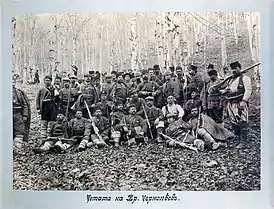
The rise of national conscience in Bulgaria led to the Bulgarian revival movement. Unlike Greece and Serbia, the nationalist movement in Bulgaria did not concentrate initially on armed resistance against the Ottoman Empire but on peaceful struggle for cultural and religious autonomy, the result of which was the establishment of the Bulgarian Exarchate on February 28, 1870. A large-scale armed struggle movement started to develop as late as the beginning of the 1870s with the establishment of the Internal Revolutionary Organisation and the Bulgarian Revolutionary Central Committee, as well as the active involvement of Vasil Levski in both organisations. The struggle reached its peak with the April Uprising which broke out in April 1876 in several Bulgarian districts in Moesia, Thrace and Macedonia. The barbaric suppression of the uprising and the atrocities committed against the civilian population increased the Bulgarian desire for independence. They also caused a tremendous indignation in Europe, where they became known as the Bulgarian Horrors. Consequently, at the 1876–1877 Constantinople Conference, European statesmen proposed a series of reforms. However, the sultan refused to implement them and Russia declared war. During the war Bulgarian volunteer forces (in Bulgarian опълченци) fought alongside the Russian army. They earned particular distinction in the epic battle for the Shipka Pass . Upon the end of the war Russia and Turkey signed the Treaty of San Stefano, which granted Bulgaria autonomy from the Sultan. The Treaty of Berlin, signed in 1878, essentially nullified the Treaty of San Stefano. Instead, Bulgaria was divided into two provinces. The northern province was granted political autonomy, and was called Principality of Bulgaria, while the southern province of Eastern Rumelia was placed under direct political and military control of the Sultan.[18]
Greeks
With the decline of the Eastern Roman Empire, the pre-eminent role of Greek culture, literature and language became more apparent. From the 13th century onwards, with the territorial reduction of the Empire to strictly Greek-speaking areas, the old multiethnic tradition, already weakened, gave way to a self-consciously national Greek consciousness, and a greater interest in Hellenic culture evolved. Byzantines began to refer to themselves not just as Romans (Rhomaioi) but as Greeks (Hellenes). With the political extinction of the Empire, it was the Greek Orthodox Church, and the Greek-speaking communities in the areas of Greek colonization and emigration, that continued to cultivate this identity, through schooling as well as the ideology of a Byzantine imperial heritage rooted both in the classical Greek past and in the Roman Empire.[19]
The position of educated and privileged Greeks within the Ottoman Empire improved in the 17th and 18th centuries. As the empire became more settled, and began to feel its increasing backwardness in relation to the European powers, it increasingly recruited Greeks who had the kind of academic, administrative, technical and financial skills which the larger Ottoman population lacked. Greeks made up the majority of the Empire's translators, financiers, doctors and scholars. From the late 1600s, Greeks began to fill some of the highest offices of the Ottoman state. The Phanariotes, a class of wealthy Greeks who lived in the Phanar district of Constantinople, became increasingly powerful. Their travels to other parts of Western Europe, as merchants or diplomats, brought them into contact with advanced ideas of the Enlightenment notably liberalism, radicalism and nationalism, and it was among the Phanariotes that the modern Greek nationalist movement matured. However, the dominant form of Greek nationalism (that later developed into the Megali Idea) was a messianic ideology of imperial Byzantine restoration, that specifically looked down upon Frankish culture, and enjoyed the patronage of the Orthodox Church.[20]
Ideas of nationalism began to develop in Europe long before they reached the Ottoman Empire. Some of the first effects nationalism had on the Ottomans had much to do with the Greek War of Independence. The war began as an uprising against the Sultan of the Ottoman Empire. At the time, Mehmet Ali, a former Albanian mercenary, was ruling Egypt quite successfully. One of his biggest projects was creating a modern army of conscripted peasants. The Sultan commanded him to lead his army to Greece and put a stop to these uprisings. At the time, nationalism had become an established concept in Europe and certain Greek intellectuals began to embrace the idea of a purely Greek state. Most of Europe greatly supported this notion, partly because ideas of Ancient Greece's mythology were being greatly romanticized in the Western world. Though the Greece at the time of the revolution looked very little like the European view, most supported it blindly based on this notion.
Mehmet Ali had his own motives for agreeing to invade Greece. The Sultan promised Ali that he would make him Governor of Crete, which would increase Ali's status. Ali's army had considerable success in putting down the Christian revolts at first, however before too long the European Powers intervened. They endorsed Greek nationalism and pushed both Ali's army and the rest of the Ottoman forces out of Greece.
The instance of Greek Nationalism was a major factor in introducing the concept to the Ottomans. Because of their failure in Greece, the Ottomans were forced to acknowledge the changes taking place in the West, in favor of Nationalism. The result would be the beginning of a defensive developmentalism period of Ottoman history in which they attempted to modernize to avoid the Empire falling to foreign powers. The idea of nationalism that develops out of this is called Ottomanism, and would result in many political, legal, and social changes in the Empire.
- In 1821 the Greek revolution, striving to create an independent Greece, broke out on Romanian ground, briefly supported by the princes of Moldavia and Muntenia.
- A secret Greek nationalist organization called the Friendly Society (Filiki Eteria) was formed in Odessa during 1814. On March 25 (now Greek Independence Day) 1821 of the Julian Calendar/6 April 1821 of the Gregorian Calendar the Orthodox Metropolitan Germanos of Patras proclaimed the national uprising.[21][22] Simultaneous risings were planned across Greece, including in Macedonia, Crete and Cyprus. The revolt began in March 1821 when Alexandros Ypsilantis, the leader of the Etairists, crossed the Prut River into Turkish-held Moldavia with a small force of troops. With the initial advantage of surprise, the Greeks succeeded in liberating the Peloponnese and some other areas.
Kurds
The system of administration introduced by Idris remained unchanged until the close of the Russo-Turkish War of 1828–29. But the Kurds, owing to the remoteness of their country from the capital and the decline of Ottoman Empire, had greatly increased in influence and power, and had spread westwards over the country as far as Angora.
After the war the Kurds attempted to free themselves from Ottoman control , and in 1834, after the Bedirkhan clan uprising, it became necessary to reduce them to subjection. This was done by Reshid Pasha. The principal towns were strongly garrisoned, and many of the Kurd beys were replaced by Turkish governors. A rising under Bedr Khan Bey in 1843 was firmly repressed, and after the Crimean War the Turks strengthened their hold on the country.
The Russo-Turkish War of 1877–78 was followed by the attempt of Sheikh Obaidullah in 1880–1881 to found an independent Kurd principality under the protection of the Ottoman Empire. The attempt, at first encouraged by the Porte, as a reply to the projected creation of an Armenian state under the suzerainty of Russia, collapsed after Obaidullah's raid into Persia, when various circumstances led the central government to reassert its supreme authority. Until the Russo-Turkish War of 1828–1829 there had been little hostile feeling between the Kurds and the Armenians, and as late as 1877–1878 the mountaineers of both races had co-existed fairly well together.
In 1891 the activity of the Armenian Committees induced the Porte to strengthen the position of the Kurds by raising a body of Kurdish irregular cavalry , which was well-armed and called Hamidieh after the Sultan Abd-ul-Hamid II. Minor disturbances constantly occurred, and were soon followed by the massacre of Armenians at Sasun and other places, 1894–1896, in which the Kurds took an active part. Some of the Kurds, like the nationalist Armenians, aimed to establish a Kurdish country.
Jews
Zionism is an international political movement; although started outside the Ottoman Empire, Zionism regards the Jews as a national entity and seeks to preserve that entity. This has primarily focused on the creation of a homeland for the Jewish People in the Promised Land, and (having achieved this goal) continues as support for the modern state of Israel.
Although its origins are earlier, the movement became better organised and more closely linked with the imperial powers of the day following the involvement of the Austro-Hungarian journalist Theodor Herzl in the late 19th century. The movement was eventually successful in establishing Israel in 1948, as the world's first and only modern Jewish State. Described as a "diaspora nationalism,"[23] its proponents regard it as a national liberation movement whose aim is the self-determination of the Jewish people.
Macedonians
The national awakening of the Macedonians can be said to have begun in the late 19th century; this is the time of the first expressions of ethnic nationalism by limited groups of intellectuals in Belgrade, Sofia,[24][25][26] Thessaloniki and St. Petersburg.[27] The "Macedonian Question" became especially prominent after the Balkan wars in 1912–1913 and the subsequent division of the Ottoman Macedonia between three neighboring Christian states, followed by tensions between them over its possession. In order to legitimize their claims, each of these countries tried to 'persuade' the population into allegiance. The Macedonist ideas grew in significance after the First World War, both in Kingdom of Yugoslavia and among the left-leaning diaspora in Kingdom of Bulgaria, and were endorsed by the Comintern.
Montenegrins
The Principality was formed on 13 March 1852 when Danilo I Petrović-Njegoš, formerly known as Vladika Danilo II, decided to renounce to his ecclesiastical position as prince-bishop and married. With the first Montenegrin constitution being proclaimed in 1855, known as "Danilo's Code". After centuries of theocratic rule, this turned Montenegro into a secular principality.
Grand Voivode Mirko Petrović, elder brother of Danilo I, led a strong army of 7,500 and won a crucial battle against the Turks (army of between 7,000 and 13,000) at Grahovac on 1 May 1858. The Turkish forces were routed. This victory forced the Great Powers to officially demarcate the borders between Montenegro and Ottoman Turkey, de facto recognizing Montenegro's centuries-long independence.
Romanians
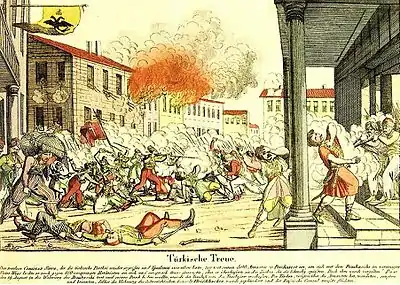
The Wallachian uprising of 1821 began as an anti-Phanariote revolt, which grew into an insurrection through the involvement of the Greek Filiki Eteria. Moldavia was occupied by Ypsilantis, while Wallachia was held by Tudor Vladimirescu. As the latter was incapable of maintaining discipline in his rebel army (the "Pandurs") and also was willing to compromise with the Ottomans, the Eteria had him arrested after the Ottoman army retook Bucharest without resistance. His army was disbanded and the rebellion suppressed after the Ottomans destroyed the Eterists in the Danubian Principalities. While unsuccessful in obtaining liberty, it ended the Phanariote era; Ottoman Sultan Mahmud II consented in 1822 to the nomination of two native boyars, Ioan Sturdza and Grigore IV Ghica as hospodars of Moldavia and Wallachia.
Serbs
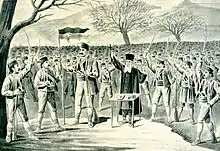
The Serbian national movement represents one of the first examples of successful national resistance against the Ottoman rule. It culminated in two mass uprisings at the beginning of the 19th century, leading to national liberation and establishment of the Principality of Serbia. One of the main centers of this movement was the Sanjak of Smederevo ("Belgrade Pashaluk") which became the core of the reestablished Serbian national state.
A number of factors contributed to its rise. Above all the nucleus of national identity was preserved in the form of the Serbian Orthodox Church which remained autonomous in one form or another throughout the period of Ottoman occupation. Adherence to Orthodox Christianity is still considered an important factor in ethnic self-determination. The Serbian Church preserved links with the medieval Serbian past, keeping the idea of national liberation alive.
The other group of factors stem from regional political events during the period of Ottoman rule, the 17th and 18th centuries in particular. The Austrian wars against the Ottoman Empire resulted in periods of Austrian rule in central Serbia (in 1718–39 and 1788–92), thus, the turn of the 19th century had saw relatively recent experience of European rule. Although the territory of northern Serbia had first reverted to Ottoman rule according to the Treaty of Belgrade, the region saw almost continuous conflict during the 18th century. As a result, the Ottomans never established full feudal order in the Belgrade Pashaluk, and free peasants owning small plots of land constituted the majority of population. Furthermore, most of the leaders of future armed rebellions earned valuable military knowledge serving in Austrian irregular troops, freikorps. The proximity of the Austrian border provided the opportunity of getting the needed military material. The Serbian leaders could also count on financial and logistic support of fellow Serbs living in relative prosperity in the Austrian Empire.
The immediate cause for the start of the First Serbian Uprising (1804–13) was mismanagement of the province by renegade Janissary troops (known as Dahije) who had seized power. While the Serbian population first rose up against the Dahije, their quick success fueled the desire of national liberation and led to a full-fledged war. Though unsuccessful, this rebellion paved the way for the Second Serbian Uprising of 1815, which eventually succeeded. Serbia became a center of resistance to Ottomans, actively or secretly supporting liberation movements in neighboring Christian-inhabited lands, especially Bosnia, Herzegovina and Macedonia. The Serbian–Ottoman conflict culminated in the First Balkan War of 1912.
Turks
Pan-Turkism emerged with the Turanian Society founded in 1839 by Tatars. However Turkish nationalism was developed much later in 1908 with the Turkish Society, which later expanded into the Turkish Hearth[28] and eventually expanded to include ideologies such as Pan-Turanism and Pan-Turkism. With the dissolution of the Ottoman Empire, the Turkish populations of the empire which were mostly expelled from the newly established states in the Balkans and the Caucasus formed a new national identity under the leadership of Mustafa Kemal along the Kemalist ideology.
Turkish revolutionaries were patriots of the Turkish national movement who rebelled against the partitioning of the Ottoman Empire by the Allies and the Ottoman government in the aftermath of the Armistice of Mudros which ended the Ottoman Empire's participation in World War I; and against the Treaty of Sèvres in 1920, which was signed by the Ottoman government and partitioned Anatolia among Allies and their supporters.
Turkish revolutionaries under the leadership of Atatürk fought during the Turkish War of Independence against the Allies supported by Armenians (First Republic of Armenia), Greeks (Greece) and the French Armenian Legion, accompanied by the Armenian militia during the Franco-Turkish War. Turkish revolutionaries rejected the Treaty of Sèvres and negotiated the Treaty of Lausanne, which recognized the independence of the Republic of Turkey and its absolute sovereignty over Eastern Thrace and Anatolia.
References
- Antonello Biagini; Giovanna Motta (19 June 2014). Empires and Nations from the Eighteenth to the Twentieth Century: Volume 1. Cambridge Scholars Publishing. pp. 143–. ISBN 978-1-4438-6193-9.
- Cagaptay 2014, p. 70.
- Stojanović 1968, p. 2.
- M. Şükrü Hanioğlu (8 March 2010). A Brief History of the Late Ottoman Empire. Princeton University Press. pp. 51–. ISBN 978-1-4008-2968-2.
- Zürcher, Erik J. (2010). The Young Turk Legacy and Nation Building: From the Ottoman Empire to Atatürk's Turkey. I.B. Tauris. p. 60. ISBN 9781848852723.
- Hechter, Michael (2001). Containing nationalism. Oxford University Press. pp. 71–77. ISBN 0-19-924751-X. OCLC 470549985.
- Charles Smith, The Arab-Israeli Conflict, in International Relations in the Middle East by Louise Fawcett, p. 220.
- Christians and Jews in the Ottoman Arab World, Bruce Masters, Cambridge
- "Archived copy". Archived from the original on 2009-11-01. Retrieved 2009-08-27.CS1 maint: archived copy as title (link)
- Richard G. (EDT) Hovannisian "The Armenian People from Ancient to Modern Times" p. 198
- Ilber Ortayli, Tanzimattan Cumhuriyete Yerel Yönetim Gelenegi, Istanbul 1985, p. 73
- "A Brief Study in the Palak Nationalism", by Dr. David Barsoum Perley LL.B.
- Sućeska 1985, p. 81.
- English translation: Leopold Ranke, A History of Serbia and the Serbian Revolution. Translated from the German by Mrs Alexander Kerr (London: John Murray, 1847)
- http://staff.lib.msu.edu/sowards/balkan/lecture5.html
- L. S. Stavrianos, The Balkans since 1453 (London: Hurst and Co., 2000), p. 248–250.
- Babuna, Aydın (1999). "Nationalism and the Bosnian Muslims". East European Quarterly. XXXIII (2): 214.
- Lord Kinross, The Ottoman Centuries: The Rise and Fall of the Turkish Empire, Morrow Quill Paperbacks (New York) 1977, p. 525.
- Encyclopædia Britannica, Greece during the Byzantine period (c. AD 300–c. 1453) > Population and languages > Emerging Greek identity, 2008 ed.
- Ροτζώκος Νίκος, Επανάσταση και εμφύλιος στο εικοσιένα, pages 131-137
- McManners, John (2001). The Oxford illustrated history of Christianity. Oxford University Press. pp. 521–524. ISBN 0-19-285439-9.
The Greek uprising and the church. Bishop Germanos of old Patras blesses the Greek banner at the outset of the national revolt against the Turks on 25 March 1821. The solemnity of the scene was enhanced two decades later in this painting by T. Vryzakis….The fact that one of the Greek bishops, Germanos of Old Patras, had enthusiastically blessed the Greek uprising at the onset (25 March 1821) and had thereby helped to unleash a holy war, was not to gain the church a satisfactory, let alone a dominant, role in the new order of things.
- "Greek Independence Day". www.britannica.com. Retrieved 2009-09-09.
The Greek revolt was precipitated on March 25, 1821, when Bishop Germanos of Patras raised the flag of revolution over the Monastery of Agia Lavra in the Peloponnese. The cry “Freedom or Death” became the motto of the revolution. The Greeks experienced early successes on the battlefield, including the capture of Athens in June 1822, but infighting ensued.
- Ernest Gellner, 1983. Nations and Nationalism (First edition), p 107-108.
- Д. Т. Левов. Лоза, Свобода, ВИ/786, Софиja, 13. 04 1892, 3.
- †Лоза#, месечно списание, издава Младата македонска книжевна дружина, Свобода, VI/774, Софија, 18. 02 1892, 3.
- mk:За македонцките работи
- К.П.Мисирков, „За Македонцките работи“, јубилејно издание, Табернакул, Скопје, 2003
- "Archived copy". Archived from the original on 2008-01-23. Retrieved 2008-03-22.CS1 maint: archived copy as title (link) (1912)
Sources
- Karpat, Kemal H. (2002). Studies on Ottoman Social and Political History: Selected Articles and Essays. BRILL. ISBN 90-04-12101-3.
- Karpat, K.H., 1973. An inquiry into the social foundations of nationalism in the Ottoman state: From social estates to classes, from millets to nations (No. 39). Center of International Studies, Princeton University.
- Karpat, K.H., 1972. The transformation of the Ottoman State, 1789-1908. International Journal of Middle East Studies, 3(3), pp. 243–281.
- Mazower, Mark (2000). The Balkans: A Short History. Modern Library Chronicles. New York: Random House. ISBN 0-679-64087-8.
- Stojanović, Mihailo D. (1968) [1939]. The Great Powers and the Balkans, 1875-1878. Cambridge University Press.
- Mete Tunçay; Erik Jan Zürcher (1994). Socialism and nationalism in the Ottoman Empire, 1876-1923. British Academic Press in association with the International Institute of Social History, Amsterdam. ISBN 978-1-85043-787-1.
- William W. Haddad; William Ochsenwald (1977). Nationalism in a non-national state: the dissolution of the Ottoman Empire. Ohio State University Press. ISBN 978-0-8142-0191-6.
- Charles Jelavich; Barbara Jelavich (20 September 2012). The Establishment of the Balkan National States, 1804-1920. University of Washington Press. ISBN 978-0-295-80360-9.
- Zeine, Z.N., 1958. Arab-Turkish Relations and the Emergence of Arab Nationalism. Khayat's.
- Kayali, H., 1997. Arabs and Young Turks: Ottomanism, Arabism, and Islamism in the Ottoman Empire, 1908-1918. Univ of California Press.
- Haddad, W.W., 1977. Nationalism in the Ottoman Empire. Nationalism in a Non-national State: the Dissolution of the Ottoman Empire, pp. 3–25.
- Roudometof, V., 1998. From Rum Millet to Greek Nation: Enlightenment, Secularization, and National Identity in Ottoman Balkan Society, 1453-1821. Journal of Modern Greek Studies, 16(1), pp. 11–48.
- Ülker, E., 2005. Contextualising ‘Turkification’: nation‐building in the late Ottoman Empire, 1908–18. Nations and Nationalism, 11(4), pp. 613–636.
- Sugar, P.F., 1997. Nationality and society in Habsburg and Ottoman Europe (Vol. 566). Variorum Publishing.
- Cagaptay, Soner (1 February 2014). The Rise of Turkey: The Twenty-First Century's First Muslim Power. Potomac Books, Inc. pp. 70–. ISBN 978-1-61234-650-2.
